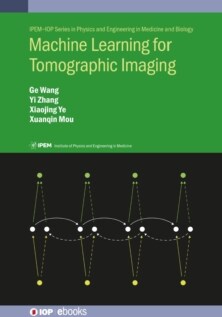
The field of artificial intelligence and machine learning, particularly the subcategory of deep learning, has experienced massive growth in recent years, with applications ranging from speech recognition to material inspection, healthcare to gaming, to name but a few. One area that’s being transformed by machine learning is tomographic imaging – in which a series of data projections (such as X-ray radiographs, for example) are reconstructed into a three-dimensional image.
A newly published book, Machine Learning for Tomographic Imaging, presents a detailed overview of the emerging discipline of deep-learning-based tomographic imaging. The book arose from discussions among four colleagues with a long-standing interest in advanced medical image reconstruction: Ge Wang from Rensselaer Polytechnic Institute, Yi Zhang of Sichuan University, Xiaojing Ye from Georgia State University and Xuanqin Mou from Xi’an Jiaotong University.
“Deep tomographic reconstruction is a new area, and the development of this area has been rapid over the past years,” explains Wang. “Ours is the first and only book on this new frontier of machine learning.”
The book begins with an introduction to imaging principles, tomographic reconstruction and artificial neural networks. Parts two and three provide in-depth tutorials on CT and MR image reconstruction and describe a range of recent machine learning techniques. The final part of the book covers other imaging modalities, including PET, SPECT, ultrasound and optical imaging, as well as taking a look at image quality evaluation and quantum computing. The text also includes appendices describing relevant numerical methods and suggesting hands-on projects, with sample codes and working datasets.
Writing in a forward to the text, Bruno De Man, a CT authority from GE Global Research, says that the book is ideal for introducing machine learning and tomographic imaging into applied disciplines such as physics and engineering, as well as for bringing application contexts into more theoretical disciplines such as mathematics and computer sciences. “Every medical imaging scientist who graduated before machine learning was taught in college should probably learn about this area in order to remain competitive,” he suggests.

A machine-learning revolution
Wang notes that the book is a little lengthy for classroom teaching. Consequently, he and his coauthors are working with the publisher (IOP Publishing) to consider a simplified version. “This will be based on my teaching experience last semester at Rensselaer Polytechnic Institute, where we performed a combined graduate/undergraduate course on medical imaging in the artificial intelligence framework. This course was the first of its kind in the world,” Wang tells Physics World. “We will keep working in this area, and hopefully produce the next version in about two years.”
- Individual copies of Machine Learning for Tomographic Imaging can be purchased at the IOP Publishing Bookstore.



